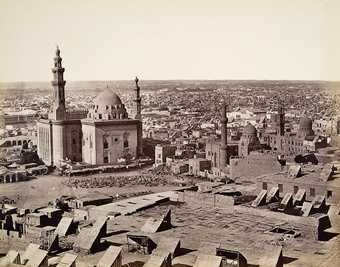In Egypt a millennium ago, Ibn al-Haytham wrote in his Kitãb al-Manãir (Book of Optics) the first scientific explanation of how light travelled in straight lines to bring an image from the outside world into our eye. He described the similar process of light travelling through a hole to bring an image into a box, a camera obscura. Eight hundred and fifty years on, in 1839, Louis Daguerre and William Fox Talbot worked out ways to fix that image on a surface with silver salts – and made a camera.
The first photographs of Egypt were taken within months of this invention, but it was the Englishman Francis Frith who first captured its sights in an accessible form. Between 1857 and 1859 he recorded views all along the Nile with a better camera that made negatives that could be used to print many pictures cheaply enough to circulate commercially in albums. Even when technology improved, these astonishing images did not go out of print, but the originals are now rare. Frith made all sorts of photographs, from magic lantern slides to stereoscopic views that appeared to be in 3D, but those produced from giant glass plates, nearly a metre squared, are the most breathtaking. Their size, never surpassed, and the suitability of the static, sunny landscape for the photographic process, created images of expansive, spectacular precision. The display at Tate Britain is the first opportunity to see them together since Frith’s own time.

Francis Frith
Cairo from the Citadel First View 1857
Mammoth plate albumen print
46.9 x 36.3 cm
He pioneered a landscape aesthetic that was specific to his subject matter and his medium. One of the first to worry about ‘getting a view satisfactorily from the camera’, he chose angles that deliberately threw out traditional proportions of sky to land. While Western artists in the East complained about the un-picturesqueness of the flat desert horizons, Frith embraced them. The Statues on the Plain of Thebes 1857 exaggerates the effect by lowering and lining up the horizontals with the layer of crops at the bottom. As a result the figures rise powerfully into the sky. Frith also exploited scale. The tiny onlookers lend the stone colossi an eerie immensity. A cloaked man silhouetted against the sky, and Frith himself standing slightly closer in a dark coat, calibrate distance.
Perhaps the most startling aspect of the mammoth plate prints is their texture. Every stem and grain of grit is clearly visible. The few minutes exposure needed to take the photographs eliminated fleeting movements. The figures that were still enough to register on the plate are immobilised like statues. This highlights the evidence of much slower change. The chipped and fractured colossi gaze from eroded faces. They dramatise the understanding of the long unfolding of geological time that was replacing Christian understandings of creation at the time.
